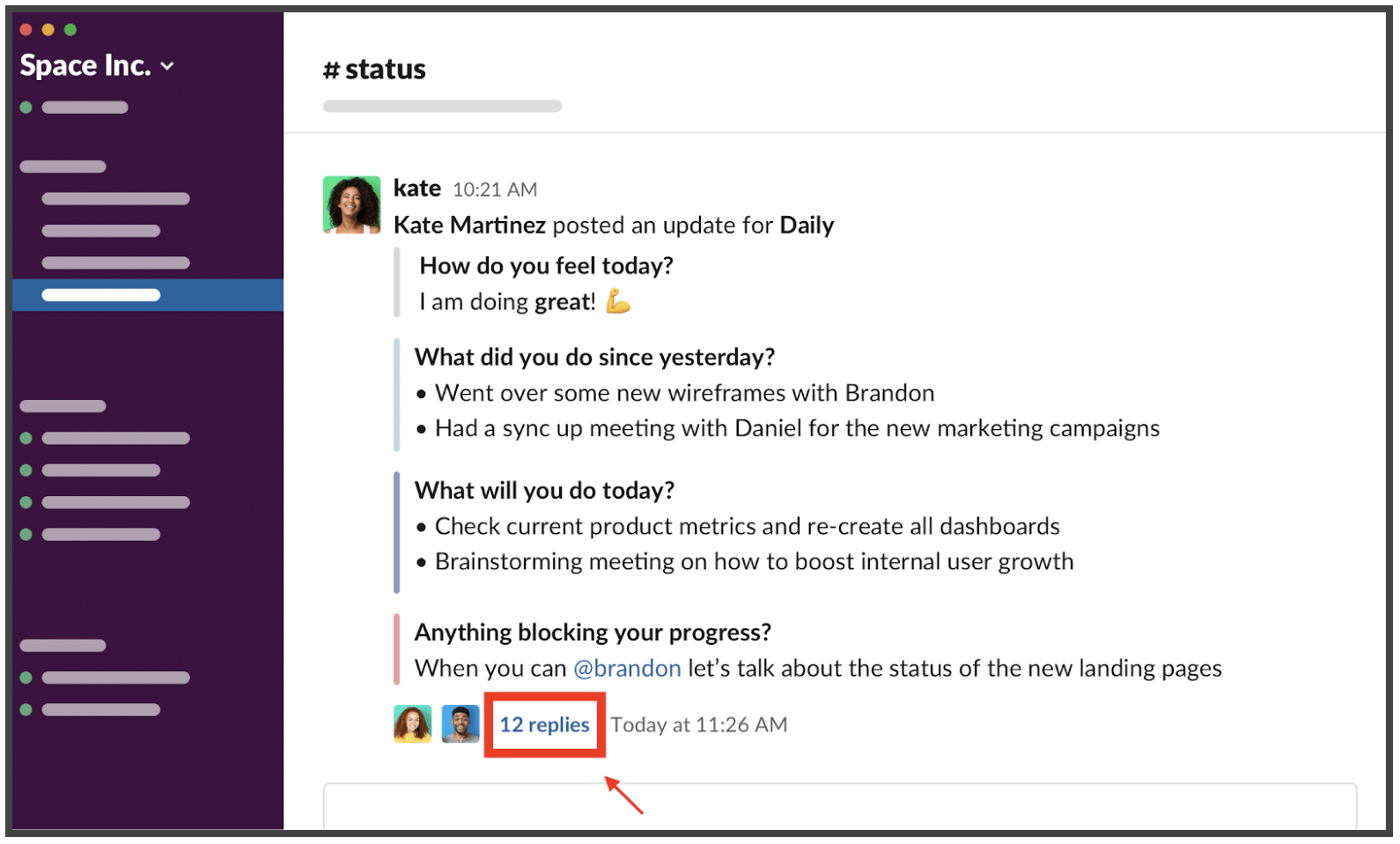A repeating theme that comes up on calls with our customers who run standup meetings is that standups are boring.
They tell us that team members have a hard time staying focused and engaged, and they often zone out and miss important information.
There are, of course, several fun standup meeting ideas you could implement to make things more lively and increase the team’s engagement, which we’ll discuss in gthis article. Things like:
- Adding “Appreciation Time” to each standup, where standup attendees can thank other team members for a contribution they recently made.
- Starting each standup with a joke, GIF, riddle, or icebreaker.
- Changing the meeting location
- Passing around a speaking token (i.e. baton or ball)
- etc.
But there’s a bigger issue here that we’ll also discuss.
Specifically, we think that standup meetings themselves can often be broken and poorly run (i.e. updates that aren’t relevant to your own work, problem solving during the standup, overly detailed updates, etc).
And that’s why team members are getting bored in the first place.
In this post, we’ll discuss several fun standup meeting ideas (Skip to List), and we’ll show how you can fundamentally fix your standups by addressing the core issues that make people disengaged.
How We’ve Set Out to Solve the Root Issues That Make Standups Boring in the First Place
In theory, standups are supposed to be an efficient use of time where team members quickly sync up, get on the same page, and understand what everyone’s next steps are (including any potential obstacles). That way, there’s less communication overhead throughout the day.
However, as anyone who has ever participated in a synchronous standup knows, in-person or video standup meetings can be a major source of frustration and seem like a waste of time for a few reasons:
- Updates are unrelated to your own work
- Interrupts you just as you get into a groove
- Too long (i.e. rambling, problem solving during standups, etc.)
- Scheduling and time zone conflicts cause inconveniences for team members
- And more…
We felt many of these issues first hand (among others), which is why our team decided to build Geekbot, a tool that lets teams hold quick and asynchronous stand-up meetings and works 100% within Slack.

If you’re curious and want more details on how Geekbot avoids the problems associated with synchronous standups, check out this post:
Video Call Downsides & How to Run Better Asynchronous Standups in Slack
We use our product everyday along with 100,000+ users, including teams within GitHub, GitLab, Shopify, Zapier, and more.
In fact, Zapier’s Strategic Apps team wrote a post on their blog about why they chose to run asynchronous, text-based standups in Slack using Geekbot, and how their standups:
- Are now “minimally disruptive”
- Only “take about a minute or so, depending on how much you type”
- Make it “easy for people to have lingering side discussions” via Slack threads that don’t interrupt and waste everyone else’s time.
With that being said, we understand that some teams may prefer to run in-person or video standup meetings.
Below, we’ll share fun standup meeting ideas that can specifically make synchronous standups more lively, and consequently, keep participants more focused and engaged.
Let’s dive in…
7 Fun Synchronous Standup Meeting Ideas
- More Casual Meeting Location
- Start Each Standup with an Icebreaker
- Appreciation Time
- Speaking Token
- Change the Frequency of Standups (i.e. Weekly or Biweekly Instead of Daily)
- Minimize Irrelevant Updates
- Rely Less on “Hacky” Solutions/Fun Standup Meeting Ideas That Don’t Address the Root of the Issue
1. More Casual Meeting Location
While many teams hold their standup meetings in a conference room (if available in their office) it could make more sense to hold the standups in a common lounge area or the kitchen to create a more casual, positive atmosphere (instead of a more formal environment that people associate with “boring” activities).
In fact, this post by The Druckman Company details how iParadigms’s team holds their standups on a couch while sitting down in front of a TV with Jira’s task board on display:
This creates a more “friendly and social” environment where people feel at ease with participating during the standup.
2. Start Each Standup with an Icebreaker
By adding a fun icebreaker before the 3 standard standup questions, it makes the standup feel less routine, and adds an element of uniqueness (especially if you use a different icebreaker each day).
Folks can finally feel like they have something fun to look forward to in a standup.
While most people may naturally think of an icebreaker as a question (i.e. “What’s your best childhood memory?”), it could also be in the form of a:
3. Appreciation Time
A great way to increase engagement is letting standup attendees go around and thank other team members for a contribution they recently made.
For example, someone could have arrived at the daily standup meeting in a bad mental space and not ready to engage and focus. But hearing positive words/appreciation from a team member can get them out of a rut, turn their mentality around, and consequently make them more motivated to participate/listen actively during the standup (and even get work done with greater enthusiasm afterwards). It’s a great team building activity that should make folks more excited to work with each other.
4. Speaking Token
No one likes getting interrupted by another teammate while they’re sharing their update during a standup. And no one likes the outcome of that, which is a standup that lasts longer than needed.
That’s why it can be a good idea to pass around a speaking token (i.e. ball or baton) — not just to add a slight element of fun to the daily meeting, but also signify whose turn it is to speak, and in effect, minimize interruptions and shorten meetings.
5. Change the Frequency of Standups (i.e. Weekly or Biweekly Instead of Daily)
While running standups on a daily basis is the accepted convention, the reality is that a weekly or biweekly meeting could make more sense for development teams whose strong suit is communication (i.e. everyone is on the same page in terms of what needs to be done to achieve the sprint goal, developers feel comfortable with asking for help when a roadblock comes up, etc.).
A weekly or biweekly meeting also makes standups feel less routine, and it’s easier to get engaged and focused for an event that occurs infrequently.
On the other hand, a daily scrum meeting makes a lot of sense for agile teams who experience difficulties with efficient communication (i.e. team members don’t like asking for help, blockers remain unresolved without a push, and there’s confusion on what tasks need to be completed to achieve the sprint goal).
6. Minimize Irrelevant Updates
It’s important to look out for when a team member starts discussing something that has no relevance to most people’s work, because the moment that happens, folks can become disengaged and zone out for the rest of the standup.
In an in-person or video standup, a facilitator or Scrum Master should step in and politely steer the conversation in the right direction, so all the status updates are relevant to those who are in the meeting, and they have a reason to stay engaged.
Of course, this issue is avoided by default with asynchronous standups via Slack, since teammates can have a private side discussion about a certain topic that only involves them without interrupting others:

7. Identifying and Understanding the Root of the Issue & Relying Less on “Hacky” Solutions/Fun Standup Meeting Ideas
As we mentioned earlier, introducing fun ideas to a standup meeting (such as an ice breaker question or a speaking token) can certainly make daily standups feel more lively… but it’s likely not going to fundamentally fix your standups or make employees who were previously zoning out love it.
Oftentimes, the underlying cause is that the standup itself is broken, and that’s why people are bored and disengaged in the first place.
We go into detail on the root issues associated with synchronous standup meetings and how to avoid these problems in the following posts:
- 11 Daily Scrum Anti-Patterns We Commonly Hear from Users [In-Depth Look]
- Standup Meetings Can Be a Waste of Time & What to Do About It
Frequently asked questions
How can I make my standups more fun?
There are a few ways to make standups more fun. First, make them shorter. If your stand-ups are running longer than 15 minutes, there’s a chance many unnecessary dialogues disengage other team members. Second, add a quick ice breaker question, an anecdote, or a customer story at the beginning. Use counting rhymes to define who answers next, or highlight someone’s achievement of the day.
How can I make my daily stand up interesting?
To make your daily stand up interesting, add variety to the meeting: add ice breaker questions, tell anecdotes, or invite people from other departments as guests (but make sure they only act as spectators). Also play around with formats, such as stand-ups with everyone standing in a circle, stand up with webcams on, stand up with background music, etc. Experiment as long as your stand-ups stay short and effective!
How do you start a fun meeting?
There are several ways to start a fun meeting. Try sharing the most recent customer review, telling a story from the latest management meeting, or adding a short engaging question at the beginning. Examples of ice breaker questions: “What was the last thing you watched this week” or “When do you think the snow starts”, or “Who would win the blindfolded boxing challenge?”



